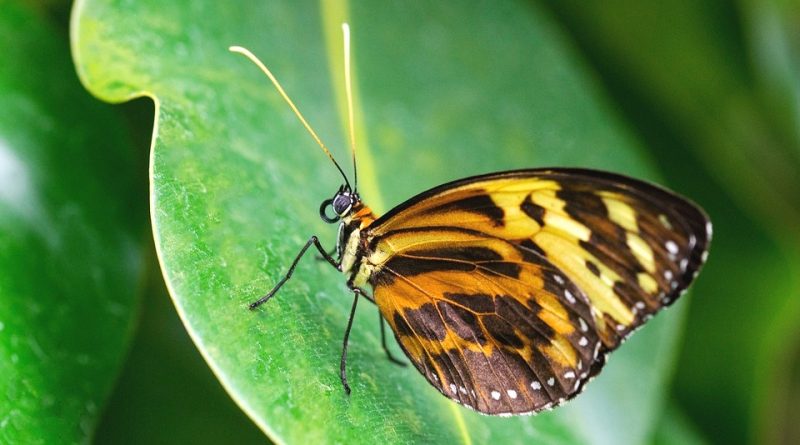Tithorea harmonia
Tithorea harmonia
The Harmonia tiger-wing (Tithorea harmonia (Cramer, 1777)) is a moth belonging to the Nymphalidae family.
Systematics –
From a systematic point of view, it belongs to the Eukaryota Domain, Animalia Kingdom, Subgenus Eumetazoa, Superphylum Protostomia, Phylum Arthropoda, Subphylum Tracheata, Superclass Hexapoda, Class Insecta, Subclass Pterygota, Cohort Endopterygota, Superorder Oligoneoptera, Subordinate Section, Infraorder Order Heteroneura, Division Ditrysia, Superfamiglia Papilionoidea, Family Nymphalidae and therefore to the genus Tithorea and to the species T. harmonia.
Within this species the following subspecies are recognized, which also occupy different territorial areas:
– T. h. brunnea Haensch, 1905 (Peru);
– T. h. caissara (Zikán, 1941) (Brazil);
– T. h. cuparina Bates, 1862 (Brazil);
– T. h. dorada Brown, 1977 (Venezuela);
– T. h. egaensis Butler, 1873 (Brazil);
– T. h. flacilla Godman & Salvin, 1898 (Colombia);
– T. h. fury Staudinger, 1884 (Ecuador – Venezuela);
– T. h. furin Godman & Salvin, 1898 (Colombia);
– T. h. gilberti Brown, 1977 (Peru);
– T. h. harmonia (Suriname, Venezuela, French Guiana);
– T. h. helicaon Godman & Salvin, 1879 (Nicaragua – Panama, Costa Rica);
– T. h. hermias Godman & Salvin, 1898 (Ecuador, Amazonia);
– T. h. hermina Haensch, 1903 (Ecuador);
– T. h. hippothous Godman & Salvin, 1879 (Guatemala);
– T. h. irene (Drury, 1782) (Panama);
– T. h. lateflava (Haensch, 1909) (Bolivia);
– T. h. Manabiana Fox, 1956 (Ecuador);
– T. h. martina Fox, 1956 (Peru);
– T. h. megara (Godart, 1819) (Trinidad);
– T. h. melanin Haensch, 1905 (Peru);
– T. h. neitha Hopffer, 1874 (Peru);
– T. h. pseudethra Butler, 1873 (Brazil);
– T. h. pseudonyma Staudinger, 1894 (Bolivia);
– T. h. salvadoris Staudinger, 1885 (El Salvador);
– T. h. sulphurata (Zikán, 1941) (Brazil).
The terms are also synonymous: Papilio harmonia Cramer, 1777, Tithorea harmonia f. moppa Bryk, 1937, Tithorea harmonia deltana Fox, 1956, Papilio irene Drury, 1782, Tithorea umbratilis Bates, 1866, Heliconia megara Godart, [1819], Tithorea flavescens Kirby, 1889, Tithorea egaensis Butler, 1873, Tithorea pseudethra Butler, 1873, Tithorea neitha Hopffer, 1874, Tithorea neitha Hopffer, 1879, Tithorea helicaon Godman & Salvin, [1879], Tithorea hippothous Godman & Salvin, [1879], Tithorea furea var. salvadoris Staudinger, 1885, Tithorea tyro Doubleday, 1847, Hirsutis pseudonyma mira Neustetter, 1929, Tithorea hermias hermina ab. napona Haensch, 1903, Tithorea assimilis Haensch, 1905, Papilio harmonia Cramer, 1777, Tithorea harmonia f. moppa Bryk, 1937, Tithorea harmonia deltana Fox, 1956, Papilio irene Drury, 1782, Tithorea umbratilis Bates, 1866, Heliconia megara Godart, [1819], Tithorea flavescens Kirby, 1889, Tithorea egaensis Butler, 1873, Tithorea pseudethra Butler, 1873, Tithorea neitha Hopffer, 1874, Tithorea neitha Hopffer, 1879, Tithorea helicaon Godman & Salvin, [1879], Tithorea hippothous Godman & Salvin, [1879], Tithorea furea var. salvadoris Staudinger, 1885, Tithorea tyro Doubleday, 1847, Hirsutis pseudonyma mira Neustetter, 1929, Tithorea hermias hermina ab. napona Haensch, 1903 and Tithorea assimilis Haensch, 1905.
Geographical Distribution and Habitat –
Harmonia tiger-wing is a species that, even through its subspecies, is widespread especially from Mexico to South America.
The habitat of this species is that of the subtropical deciduous forest and of the evergreen rainforest where it lives and reproduces between 0-1300 m. s.l.m.
They can be observed while flying in sunny glades where they can easily be confused with Heliconius species such as Ismenius, Numata or Hecale
Both sexes visit flowers including Psychotria, Hamelia and Chomelia.
Morphology –
Tithorea harmonia is recognized for having a wingspan that reaches about 70 millimeters.
The wings are characterized by black wings crossed by bands and orange patterns of bright color and with the upper edge of black.
The antennas are bright orange. The legs and the spiritromba are black.
The larvae are dark in color with a large clear punctuation all over the body; the head and the antennas are dark.
The chrysalises appear with a typical golden color.
The identification of tiger butterflies is notoriously very difficult even for experts, due to the similarity of the different striped liveries also between species belonging to subfamilies or tribes genetically very distant from each other.
Attitude and biological cycle –
The larvae of Tithorea harmonia feed on Prestonia acutifolia (Apocynaceae). These food plants contain toxins that are ingested by larvae and transmitted to adult butterflies, making them extremely unpleasant and toxic (due to the pyrrolizidine alkaloids) for birds.
The adults of this butterfly usually meet individually, but in some areas there may be even more individuals flying together, most likely where the feeding conditions for the butterfly are more advantageous.
The eggs are laid under the leaves of the plants on which the larvae feed.
Ecological Role –
In sunny weather, Tithorea harmonia tends to get stuck in the thick vegetation of tropical areas. In cloudy conditions, or as dusk approaches, these butterflies begin to fly in the most open areas, along the edges of rivers or in wide forest clearings. It is the moment when they can be observed fluttering among the grasses or resting on the low leaves, moving the wings slowly.
Instead, during rainy events they hide among the roots of palm trees.
Males are commonly attracted to bird droppings, from which they sequester pyrrolizidine alkaloids. These chemical products have multiple purposes: they increase the toxicity of the butterfly making it unpleasant to birds, are essential in the production of pheromones and are transferred to the female during copulation, thus increasing its longevity and fertility.
Both sexes visit flowers including Psychotria, Hamelia and Chomelia. In addition, long periods can be spent finding the nectar by returning to the flower for a period of several days.
These butterflies, at the end of the dry season, tend to collect the last remaining moisture sources inside the forest, such as dry river beds, wetlands or muddy pools.
Guido Bissanti
Sources
– Wikipedia, the free encyclopedia.
– Russo G., 1976. Agrarian Entomology. Special Part. Liguori Editore, Naples.
– Tremblay E., 1997. Applied entomology. Liguori Editore, Naples.

